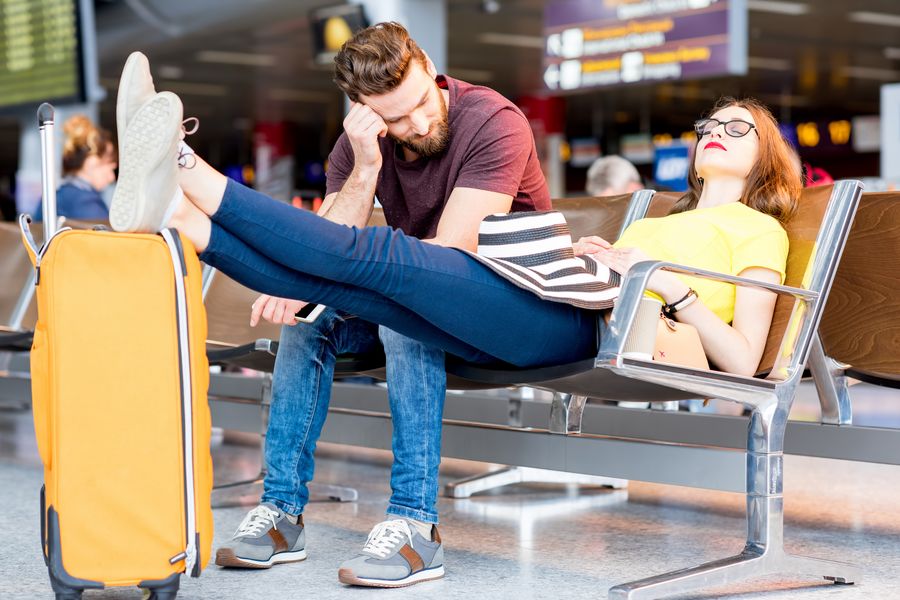Travel can be hard on your body. Spending long hours traveling in a car, train or airplane can leave you feeling tired, sore, stiff, and stressed out. This is because prolonged periods of sitting can cause harm to your body like restricted blood flow from sitting in awkward positions. When you sit in the same position for a long period of time, it can cause a pressure buildup in your lower legs. To help to get your blood flowing properly, it is important for you to contract and relax your muscles. Here are some tips to help you to relieve the strains and aches that are associated with travel.
Make sure to warm up and cool down
Before you begin traveling, view your upcoming trip like a sport. You should warm up before you settle into your seat by taking a brisk walk around the airport or in your neighborhood so that your calf and hamstring muscles are stretched.
While you are flying
While you are flying in an airplane, stand up once in a while after you are allowed to remove your seat belt. When you do, make certain that you stand straight. When you sit down, use blankets or pillows to maintain the proper spine curvature. You can tuck a blanket behind your lower back and a pillow between your neck and your seat’s headrest.
Before you board the plane, you should check any bag that weighs more than between 5 to 10 percent of your own weight. Lifting heavy items overhead to place in a bin should be avoided. When you lift your bags, stand straight in front of the compartment and lift in a manner that you do not rotate your spine.
When you stow your belongings beneath a seat, don’t force them using awkward motions with your arms, legs, or feet. This can cause your muscles to spasm and for you to experience pain. Sit down in your seat and then use your feet and hands to gently slide your belongings under the seat that is directly in front of your own.
Make certain to vary your position from time to time while you are seated so that your circulation will be improved. Massage your calf muscles and your legs occasionally. Try to avoid sitting directly under the plane’s air controls because drafts can increase neck tension.
When you are traveling by automobile
When you travel by auto, you should make certain that your seat is adjusted to where you can sit as close to the steering wheel as you comfortably can. If you are seated correctly, your knees should be positioned slightly above the position of your hips. Put four fingers behind your thigh close to your knee. If you are not able to slide your fingers in this area easily, you should readjust your seat.
Using a back support may help if you suffer from pain in your lower back. You can place the widest area of the support between your waistline and your rib cage. While you are driving, you can complete simple leg exercises. You can open your toes widely while counting to 10. Then, tighten your calf muscles while counting to five, and repeat with your thighs and your gluteals. While keeping your hands on the steering wheel, do some shoulder rolls. You can help to reduce tension in your hands and arms by holding your steering wheel at the three and seven o’clock positions.
Avoid gripping the steering wheel. You should alternate tightening and loosening your grip to help to decrease muscle fatigue. Make certain to take breaks during your trip. You should never continue to try to drive when you are fatigued or drowsy. Instead, you should pull off of the road and take a break for 30 minutes or longer.
Children’s safety
If you have a child who is younger than age four and who weighs less than 40 pounds, he or she should be in a certified car seat. You should also check the requirements for older children in the states through which you will travel. Some require booster seats for children as old as eight.
You can ask your airline about child car seat safety while your children are flying. Riding in car seats is safer than riding on a parent’s lap if an accident happens.
Car seats should fit your child’s size and age. If you have an infant, his or her car seat should face the rear so that the impact of any accident spreads across the back. Children should always ride in the back seat of a car. If your vehicle has side-impact airbags, the car seat should be in the center of the back seat.
Learn more with the Absolute Health Center
While following these tips may not protect you from all accidents, they can help you to experience less pain when you are traveling. If you suffer from pain after traveling, Dr. Weigle and the staff of Absolute Health Chiropractic Center in Gainesville, Florida are available to help you. Contact us today to schedule your appointment.
